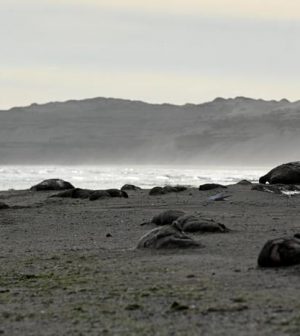- Skip Storing This Everyday Product in the Fridge Door
- Green Tea + B3 Pairing May Boost Brain Health
- Navigating Your Midlife Crisis: Embracing New Possibilities
- City Raccoons Showing Signs of Domestication
- Mapping the Exposome: Science Broadens Focus to Environmental Disease Triggers
- One Week Less on Social Media Linked to Better Mental Health
- Your Brain Changes in Stages as You Age, Study Finds
- Some Suicide Victims Show No Typical Warning Signs, Study Finds
- ByHeart Formula Faces Lawsuits After Babies Sickened With Botulism
- Switch to Vegan Diet Could Cut Your Greenhouse Gas Emissions in Half
Bird Flu Found in Sea Mammals, Upping Risk to Humans

Bird flu has mutated to spread more easily between birds and marine mammals, increasing the potential risk to humans, a new study warns.
Four sea lions, one fur seal and a tern found dead in Argentina all tested positive for the avian influenza virus H5N1, researchers report.
Further, genetic analysis revealed that the virus was nearly identical in all the animals, and shared adaptations were previously detected in a human case in Chile as well as in sea lions in Peru and Chile.
The fact that the same virus was found in the tern indicates a multi-species outbreak, researchers noted.
“This confirms that while the virus may have adapted to marine mammals, it still has the ability to infect birds,” said lead researcher Agustina Rimondi, a virologist from the National Institute of Agricultural Technology in Argentina.
The current variant of H5N1 — clade 2.3.4.4b — is considered a “new monster” by senior researcher Marcela Uhart, a wildlife veterinarian with the University of California, Davis.
“This virus is still relatively low risk for humans,” Uhart said in a university news release.
However, “as long as the virus continues to replicate in mammals, it may make it a higher concern for humans,” he added. “That’s why it’s so important to conduct surveillance and provide early warning.”
The new variant emerged in 2020, during the pandemic, and began killing tens of thousands of sea birds in Europe before moving to South Africa.
In 2022, the variant entered the United States and Canada before migrating to Peru and Chile and entering Argentina in February 2023.
Six months later, in August 2023, the variant was first found in sea lions at the tip of South America, on the Atlantic coastline of Tierra del Fuego. It then moved swiftly northward, sickening and killing first marine mammals and later seabirds.
A recent paper co-authored by Uhart reported a large outbreak that killed 70% of elephant seal pups during the 2023 breeding season, with mortality rates reaching at least 96% in surveyed regions of Argentina.
“When it first came to Argentina, we didn’t know if it would affect elephant seals,” Uhart said. “We never imagined the magnitude of what was to come.”
Since 2022, the H5N1 bird flu has killed at least 600,000 wild birds and 50,000 mammals in South America. The deaths included elephant seals and sea lions in Argentina, Chile and Peru, and thousands of albatrosses in the Malvinas/Falkland Islands.
The virus is also headed southward from South America, and researchers are worried about a potential outbreak among penguins and other wildlife in Antarctica.
The new study was published Feb. 27 in the journal Emerging Infectious Diseases.
“We need to keep an eye on the ability of this virus to reach species that have never been exposed to an H5N1 infection before,” Rimondi said. “The consequences in those species can be very severe.”’
More information
The U.S. Centers for Disease Control and Prevention has more about H5N1 bird flu.
SOURCE: University of California, Davis, news release, Feb. 28, 2024
Source: HealthDay
Copyright © 2025 HealthDay. All rights reserved.










